A Beginner’s Guide to E-Learning and Popular E-Learning Tools
E-learning (also called online learning) is still relatively new—the term “e-learning” was coined just over 20 years ago. But despite its short lifespan, e-learning has quickly gained popularity in classrooms and corporate offices across the world. While e-learning has obviously gained popularity during the pandemic, any investment in an e-learning tool will have benefits for learners and educators long after the pandemic is over.
If you’re new to e-learning, not to worry. This guide will explain the ins and outs of e-learning and help you discover tools that can revolutionize your teaching or training strategy.
Here’s what we’ll cover:
What is e-learning?
Gartner defines e-learning as “the use of technology for learning in or outside of a classroom.” While it mostly applies in an educational context, e-learning can also describe employee training or online certification classes.
In the education industry, e-learning courses are becoming increasingly popular—especially due to the COVID-19 pandemic. Many schools, colleges, and universities offer e-learning courses for traditional, remote, and continuing education students. For corporations, e-learning is frequently used to train new employees and help existing employees learn new policies and processes.
What are the benefits of e-learning?
In an educational setting, students have more flexibility with online courses because they can attend classes from anywhere. They can also save money without the obligation to commute or live near their school. On the other side of the coin, schools can feature lectures from instructors all over the world without footing the bill for their travel.
Other benefits of e-learning for schools include:
Generate more accurate student performance reports
Easily update courses with relevant, timely learning content
Reduce your school’s environmental impact
Personalize help based on students’ unique needs
For businesses, e-learning is typically less expensive and easier to implement than traditional forms of training. Online training mitigates the costs of instructors, training rooms, travel, catering, and any materials needed for in-person training.
Other benefits of e-learning for businesses include:
Employees have just-in-time accessibility (meaning they can search for and access materials on their mobile phones and other devices at any time)
Systems offer scalability, so fluctuations in users is easy to manage
Training consistency and standardization is easy to execute
Business’ environmental impact is reduced
Employees have ongoing access to key resources
What are the different types of e-learning?
E-learning typically falls into two categories: asynchronous and synchronous.
Asynchronous e-learning refers to self-paced online courses that learners can complete on their own timeline. This kind of e-learning does not require instructors and students to be online simultaneously. Learners working through asynchronous courses use discussion forums, message boards, pre-recorded video lectures, and other assets to complete these courses.
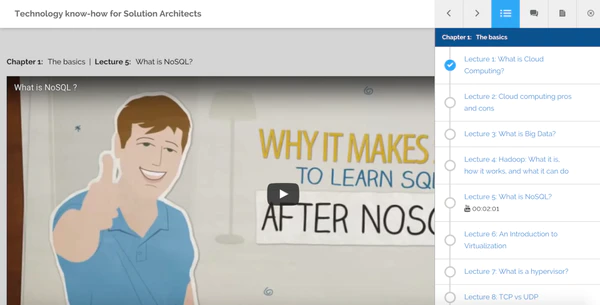
Modules in a self-paced course in BrainCert (Source)
Alternatively, synchronous e-learning happens in real-time, meaning learners and instructors are online at the same time. In this type of e-learning, lessons are delivered in a virtual classroom, and students use live chat, video conferencing, and application sharing to participate in the course.
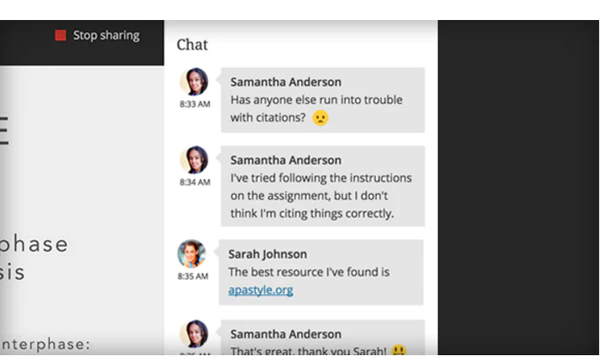
Live chat in Blackboard Collaborate (Source)
There are many e-learning tools on the market that support asynchronous and synchronous e-learning, but it’s best to know what kind of courses you plan to create before choosing one. Before we get too far ahead of ourselves, let’s dive into what e-learning software is.
What is e-learning software?
E-learning software (sometimes called e-learning authoring software or course authoring software) refers to the tools used to create educational or training materials.
Some of the most common features of e-learning software include:
Templates: Use pre-configured models for different types of e-learning materials, such as lessons or quizzes.
Multimedia authoring: Upload and edit multimedia files to create e-learning resources.
Testing tools: Track learner progress through quizzes, exams, and tests.
Customization: Add your organization’s branding to your online course.
SCORM compliance Create SCORM-compliant materials.
What is SCORM?
Shareable Content Object Reference Model (SCORM) refers to a collection of standards and specifications for web-based electronic educational technology. SCORM matters because successful e-learning delivery requires your LMS to read, run, and report on course content. SCORM helps your e-learning platform and course content understand each other and work together.
E-learning software is often accompanied by a learning management system (LMS). LMSs automate the administration, testing, tracking and reporting of learner progress through online courses. Some LMS are built with course authoring functionality, but you can also choose an LMS and e-learning software that integrate with one another.
Learn more about LMSs:
Now that you understand what e-learning software is, let’s take a look at 5 popular tools.
Products are listed alphabetically. To learn more about the methodology we used to feature products, click here.
5 popular e-learning tools
1. Absorb LMS
User rating: 4.39/5
Absorb LMS is a cloud-based learning management system that’s used by businesses of all sizes in a variety of industries. While Absorb offers a content library with thousands of pre-built online courses, you can also create your own custom courses through their platform.
With Absorb’s custom course development tool, you can start from scratch or refine existing materials to create audiovisual lectures, microlearning courses, and simulations. You can even design materials meant to be used in a blended learning environment such as offline on-the-job aids, instructor guides, companion materials, and participant manuals. One notable benefit of the custom course development path is access to the Absorb’s Learning Solutions Services team, the vendor’s in-house support team with decades of LMS course development expertise.
Absorb LMS features include:
AICC/SCORM support
Gamification
Built-in course authoring
Gradebook
Custom branded learner interface
Social learning
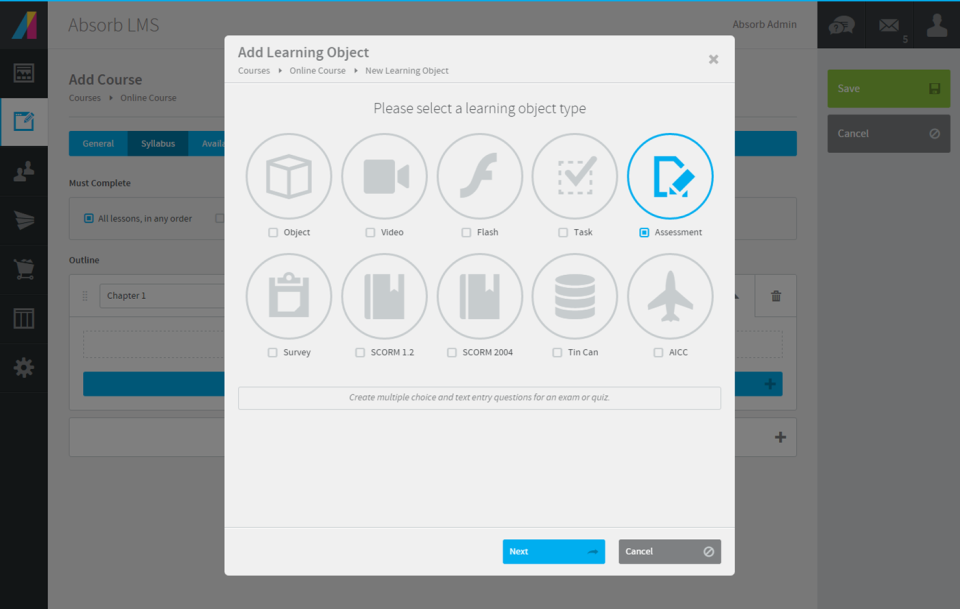
Editing a course in Absorb LMS (Source)
2. Articulate 360
User rating: 4.73/5
Articulate 360 is an e-learning platform that helps businesses of all sizes create their own online courses. With Articulate’s platform you’ll have access to Content Library 360, a collection of over 6 million course assets including templates, images, and videos. You’ll also be able to collaborate with stakeholders through Review 360, a function that allows your team to leave feedback directly in your content draft.
Articulate 360 also comes with Storyline 360 and Rise 360, smart authoring tools that allow you to drag and drop assets, create interactive elements and simulations, and automatically optimize your content for any device.
Articulate 360 features include:
SCORM compliance
Content import/export
Test/quiz creation
Self-paced courses
Course publishing

Feedback left via Review 360 in a course created with Articulate 360 (Source)
3. eFront
User rating: 4.56/5
eFront is an LMS platform for midsize to large businesses. eFront is primarily used by corporations for onboarding, training, compliance, and professional development purposes.
Along with a marketplace where you can choose from thousands of ready-made courses, eFront gives you the ability to create your own as well. Highlights of eFront’s platform include the ability to create learning paths based on skill-gap testing and rich internal communication features such as email, calendars, and discussion forums.
eFront features include:
Mobile learning
Built-in course authoring
Gamification
Custom branding
Self-enrollment
Test/quiz creation
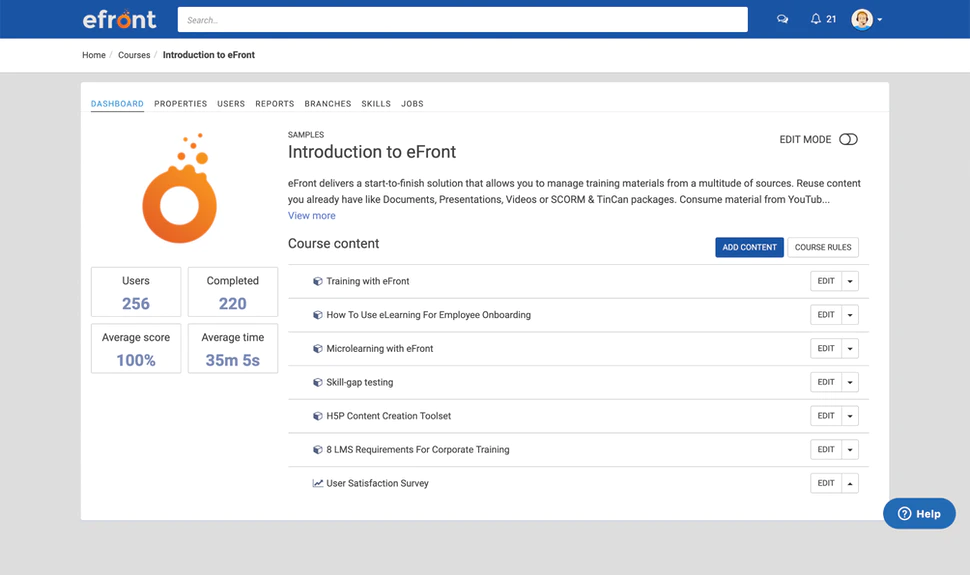
Course dashboard in eFront (Source)
4. LearnUpon
User rating: 4.86/5
LearnUpon is an LMS used by businesses of all sizes to achieve their learning goals. LearnUpon has four different LMS solutions, each designed for either employee, customer, partner, or compliance training.
Course authoring with LearnUpon is easy—just upload content, then drag and drop within their templates to create a course. You can import audio and video files, as well as Word docs, PowerPoint presentations, and PDFs. LearnUpon supports synchronous e-learning by giving you the ability to host live lessons through an integration with video conferencing software. One other notable feature is the survey functionality, which can help you capture feedback on courses and instructors from learners.
LearnUpon features include:
Built-in course authoring
Gamification
Test/quiz creation
Social learning
Custom branded learner interface
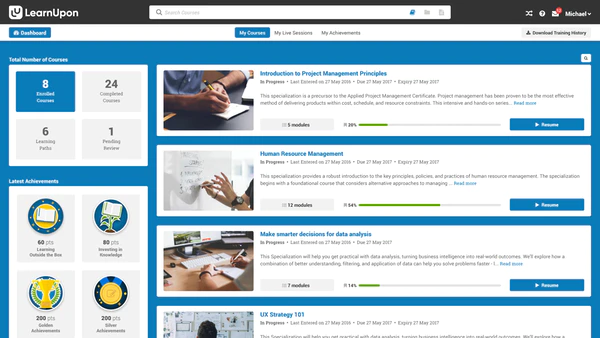
Learner dashboard showing courses in LearnUpon (Source)
5. Lessonly
User rating: 4.71/5
Lessonly is an easy-to-use learning management system for any size business. To create a course in Lessonly, you can upload audio, image, video, or text files and arrange them however you want. One of Lessonly’s offerings is Lessonly Services, a support team that can help you build courses and learning paths based on your business’s goals.
Another notable aspect of Lessonly’s platform is Practice, a feature that gives your team the ability to … practice! This function allows your employees to rehearse interactions with customers through webcam and audio recordings, written responses, chat practice, and ticket practice.
Lessonly features include:
Assignment management
Gradebook
Built-in course authoring
Test/quiz creation
Asynchronous learning
Interactive content
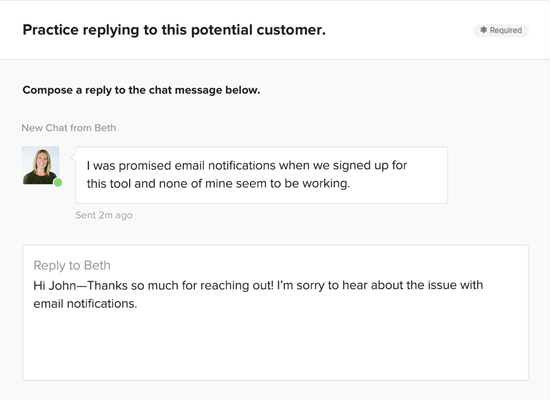
Chat practice in Lessonly (Source)
Start your e-learning software selection journey
If you’re interested in learning more about additional tools, check out our list of products with real user reviews alongside. We’ve also created a E-learning Software Buyers Guide with information on the vendor landscape, benefits of the software, and more.
If you’d like a real person to chat with about software and your specific business, our experts are always happy to help. It’s free for you. Click here to schedule an appointment for a phone call or start a live chat here.
How we chose featured products:
We determined the most popular products to feature by choosing those highest ranked in Google search results for the term “e-learning software” during the week of September 7, 2020. The top search results were vetted to ensure they offer basic course authoring capabilities such as content import and export, built-in course authoring, and testing or quiz creation functionalities.